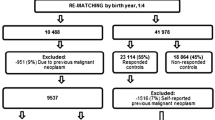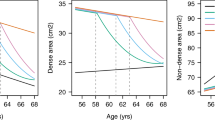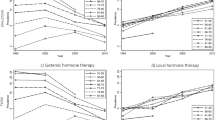Background
The news media facilitated the rapid dissemination of the findings from the estrogen plus progestin therapy arm of the Women’s Health Initiative (EPT-WHI).
Objective
To examine the relationship between the potential exposure to newspaper coverage and subsequent hormone therapy (HT) use.
Design/Population
Population-based cohort of women receiving mammography at 7 sites (327,144 postmenopausal women).
Measurements
The outcome was the monthly prevalence of self-reported HT use. Circulation data for local, regional, and national newspapers was used to create zip-code level measures of the estimated average household exposure to newspaper coverage that reported the harmful effects of HT in July 2002.
Results
Women had an average potential household exposure of 1.4 articles. There was substantial variation in the level of average household exposure to newspaper coverage; women from rural sites received less than women from urban sites. Use of HT declined for all average potential exposure groups after the publication of the EPT-WHI. HT prevalence among women who lived in areas where there was an average household exposure of at least 3 articles declined significantly more (45 to 27%) compared to women who lived in areas with <1 article (43 to 31%) during each of the subsequent 5 months (relative risks 0.86–0.92; p < .006 for all).
Conclusions
Greater average household exposure to newspaper coverage about the harms associated with HT was associated with a large population-based decline in HT use. Further studies should examine whether media coverage directly influences the health behavior of individual women.

Similar content being viewed by others
References
Rossouw JE, Anderson GL, Prentice RL, et al. Risks and benefits of estrogen plus progestin in healthy postmenopausal women: principal results from the Women’s Health Initiative randomized controlled trial. JAMA. 2002;288(3):321–33.
Haas JS, Kaplan CP, Gerstenberger EP, Kerlikowske K. Changes in the use of postmenopausal hormone therapy with the publication of clinical trial results. Ann Intern Med. 2004;140(3):184–8.
Hersh AL, Stefanick ML, Stafford RS. National use of postmenopausal hormone therapy: annual trends and response to recent evidence. JAMA. 2004;291(1):47–53.
Buist DS, Newton KM, Miglioretti DL, et al. Hormone therapy prescribing patterns in the United States. Obstet Gynecol. 2004;104(5 Pt 1):1042–50.
Phillips DP, Kanter EJ, Bednarczyk B, Tastad PL. Importance of the lay press in the transmission of medical knowledge to the scientific community. N Engl J Med. 1991;325(16):1180–3.
Johnson T. Shattuck lecture-medicine and the media. N Engl J Med. 1998;339(2):87–92.
Newton KM, Lacroix AZ, Leveille SG, Rutter C, Keenan NL, Anderson LA. The physician’s role in women’s decision making about hormone replacement therapy. Obstet Gynecol. 1998;92(4 Pt 1):580–4.
McIntosh J, Blalock SJ. Effects of media coverage of Women’s Health Initiative study on attitudes and behavior of women receiving hormone replacement therapy. Am J Health Syst Pharm. 2005;62(1):69–74.
Schwartz LM, Woloshin S. The media matter: a call for straightforward medical reporting. Ann Intern Med. 2004;140(3):226–8.
Dearing J, Rogers E. Agenda Setting. Thousand Oaks, CA: Sage; 1996.
Fan DP. Impact of the mass media on calls to the CDC National AIDS Hotline. Int J Biomed Comput. 1996;41(3):207–16.
Danovaro-Holliday MC, Wood AL, LeBaron CW. Rotavirus vaccine and the news media, 1987–2001. JAMA. 2002;287(11):1455–62.
Soumerai SB, Ross-Degnan D, Kahn JS. Effects of professional and media warnings about the association between aspirin use in children and Reye’s syndrome. Milbank Q. 1992;70(1):155–82.
Nattinger AB, Hoffmann RG, Howell-Pelz A, Goodwin JS. Effect of Nancy Reagan’s mastectomy on choice of surgery for breast cancer by US women. JAMA. 1998;279(10):762–6.
Domenighetti G, Luraschi P, Casabianca A, et al. Effect of information campaign by the mass media on hysterectomy rates. Lancet. 1988;2(8626–8627):1470–3.
Tesoriero JM, Sorin MD. The effect of “Magic” Johnson’s HIV disclosure on anonymous HIV counseling and testing services in New York State. AIDS & Public Policy Journal. 1992;7:216–24.
Maclure M, Dormuth C, Naumann T, et al. Influences of educational interventions and adverse news about calcium-channel blockers on first-line prescribing of antihypertensive drugs to elderly people in British Columbia. Lancet. 1998;352(9132):943–8.
Ballard-Barbash R, Taplin SH, Yankaskas BC, et al. Breast Cancer Surveillance Consortium: a national mammography screening and outcomes database. Am J Roentgenol. 1997;169(4):1001–8.
Haas JS, Geller B, Miglioretti DL, et al. Changes in newspaper coverage about hormone therapy with the release of new medical evidence. J Gen Int Med. 2006:21;304–9.
Friedman SM, Dunwoody S, Rogers CLE. Communicating uncertainty: Media coverage of new and controversial science. Mahwah, NJ: Erlbaum; 1999.
Manning P. News and news sources: A critical introduction. London: Sage; 2001.
Nelkin D. How the press covers science and technology. New York: W. H. Freeman; 1995.
Audit Bureau of Circulations. http://www.accessabc.com (accessed February 3, 2006).
Liang KY, Zeger SL. Longitudinal data analysis using generalized linear models. Biometrika. 1986;73(1):13–22.
Heagerty PJ, Lumley T. Window subsampling of estimating functions with applications to regression models. J Am Stat Assoc. 2000;95:197–211.
Ettinger B, Grady D, Tosteson AN, Pressman A, Macer JL. Effect of the Women’s Health Initiative on women’s decisions to discontinue postmenopausal hormone therapy. Obstet Gynecol. 2003;102(6):1225–32.
Tichenor PJ, Donohue GA, Olien CN. Community Conflict and the Press. Beverly Hills, CA: Sage; 1980.
Grilli R, Ramsay C, Minozzi S. Mass media interventions: effects on health services utilisation. Cochrane Database Syst Rev. 2002(1):CD000389.
Yanovitzky I, Blitz CL. Effect of media coverage and physician advice on utilization of breast cancer screening by women 40 years and older. J Health Commun. 2000;5(2):117–34.
Psaty BM, Heckbert SR, Koepsell TD, et al. The risk of myocardial infarction associated with antihypertensive drug therapies. JAMA. 1995;274(8):620–5.
Brunt ME, Murray MD, Hui SL, Kesterson J, Perkins AJ, Tierney WM. Mass media release of medical research results: an analysis of antihypertensive drug prescribing in the aftermath of the calcium channel blocker scare of March 1995. J Gen Intern Med. 2003;18(2):84–94.
Project for Excellence in Journalism. The State of the News Media 2005. http://www.stateofthenewsmedia.org/2005/index.asp (accessed February 3, 2006).
National Center for Health Statistics. Health, United States, 2005. Hyattsville, MD: Department of Health and Human Services, 2005.
Acknowledgment
NCI staff with specific expertise relevant to this effort participated in multiple aspects of this project, including design, collection, management, analysis and interpretation of the data, and manuscript preparation. NCI provided support to this project through the BCSC cooperative agreements noted above that underwent peer review. The final version of the manuscript was approved by all study authors and principal investigators of the BCSC sites. The authors thank Mary Canales, PhD, RN; Anne Dorwaldt; and Anush Yousefian, MS for their help with abstracting the newspaper articles.
Financial Support
This work was supported by National Cancer Institute (NCI)-funded Breast Cancer Surveillance Consortium (BCSC) co-operative agreements (U01CA86076, U01CA63740, U01CA86082, U01CA69976, U01CA63736, U01CA63731, U01CA70013, and U01CA70040).
Potential Financial Conflicts of Interest
None disclosed.
Author information
Authors and Affiliations
Corresponding author
Rights and permissions
About this article
Cite this article
Haas, J.S., Miglioretti, D.L., Geller, B. et al. Average Household Exposure to Newspaper Coverage about the Harmful Effects of Hormone Therapy and Population-Based Declines in Hormone Therapy Use. J GEN INTERN MED 22, 68–73 (2007). https://doi.org/10.1007/s11606-007-0122-7
Published:
Issue Date:
DOI: https://doi.org/10.1007/s11606-007-0122-7




